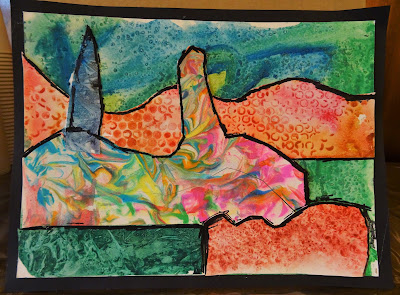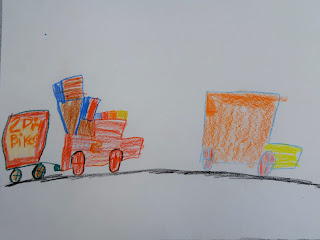This is a tough thing for me, having the results be unsuccessful. While I'm all about giving kids an exciting exploratory process, I also feel that art is made to be seen, to be experienced visually, just like music is made to be heard, to give the listener a distinct auditory experience. So making a product that looks good is equally as important to me as the process itself. I know this can be a controversial topic, but that's been my outlook for a long time, and I don't expect it to change. Plus, I am teaching in a private business, and my students' parents pay for their children to attend, so I feel an obligation for the kids to produce a product that they can show off at the end of a session.
Anyhow... A couple of months back, someone posted a project on Facebook that looked a lot like felting, but without wool, and I was instantly intrigued. It was based on a project that had been shared in the United Art & Education booth at the NAEA convention in Chicago, but somehow I hadn't seen it there. It is available on line, and here is a link to the original Project PDF, courtesy of United Art & Education: Fiber Painting - Project #197.
I looked at the original project, and I looked at the adaptations made by the person who posted on Facebook, and I made some other adjustments to hopefully make it easier for me and my young students to do. My DragonWing Arts students were doing projects based on the theme of "Scapes" - Landscapes and Seascapes and so on. I thought this project would fit in perfectly, for layers of mountains and cloudy skies. The method uses polyester fiberfill, and I have a monstrous 10 pound carton left over from my grand experiment building a duct tape dummy. (You can read about that crazy misadventure right HERE.)
But back to this project... I gave my students one rubber glove each, so they would end up with one clean hand to turn on the water at the sink at cleanup time. I put small amounts of acrylic paints in disposable cups, and put out a big bag full of the fiberfill. The kids then pulled off small hunks of fiber, dipped it in the color paint of their selection, and then pulled and twisted it in their hands, mixing the color into the fiber. It was an enormous bunch of fun, and the kids made a huge pile of colored fiberfill, to use in our fiber landscape paintings. The stuff in this bucket is just a small portion of what the kids created.
As you can see in the following pictures, the kids loved every minute of making the colorful fiber.
But then, we had this huge bin filled with colored fiberfill, and it was time to make it into pictures. It sounded like a simple proposition. But it was not. It was extremely challenging.
The kids drew simple landscape images onto pieces of mat board, and then used pop sticks to spread tacky glue on an area where they wanted to place a certain color of fiber. The fiber was then pressed into the glue. And it was NOT EASY. The most successful piece (or maybe I should say the ONLY successful piece) is the one of a tree (in case you couldn't tell) pictured at the top of this post. The others... not so much.
The kids tried hard. One kid tried to do a sky with a sun and clouds, but it just looks like blobs of color. Another attempted a volcano, but again, it is unrecognizable. And I don't think I was ever sure of what the 4th student was making. In the end, you just couldn't tell what the heck the pictures were. I even had a hard time being successful. Below is my unfinished sample. My sad little lollipop tree looks like it popped its top!
And now, the multi-week session is over, and the kids have taken home all their work. I can't seem to find a single photo of any of the student pieces besides the one at the top of the post, unless you want to look closely at their mini "art show" pictures, found in this post HERE. The lack of pictures wasn't intentional; we just got so busy I guess I missed taking pictures of them all.
How do you feel when you do an art project with kids where the resulting product is not at all what you intend or expect? Are you satisfied that the process alone was worthwhile, even if the product is not successful? And now what in the world do I do with the mountain of leftover colorful fiber that I have, as well as the rest of that 10 pound box, which still seems just as full?




















































